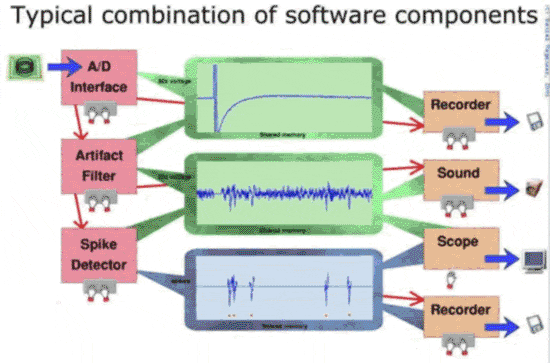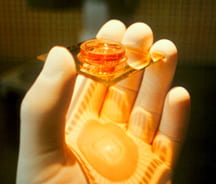As part of our lab’s effort to study learning in vitro by connecting living neural networks to a simulated body in a simulated environment (the Animat project), we have developed a set of tools for online and offline analysis of data collected from MEAs (multi electrode arrays).
Setup
We grow cultures of thousands of neurons dissociated from cortex of E18 rat embryo on dishes with a rectangular array of 60 microelectrodes spaced at 200 um. Although such cultures are enormously simplified model systems when compared to the intact brain, they still exhibit rich dynamics at a variety of timescales.
Cultures are maintained in dishes sealed with a gas-permeable membrane that allows them to be grown in a non-humidified incubator and keeps them from getting infected upon repeated observations. We have used this technique to grow primary neuron cultures for up to two years. Because the incubator is not humidified, it is amenable to electronics, including continuous stimulation and recording via the MEA.

Software
We use two custom software solutions for real-time closed loop control of Neural Systems.
1. NeuroRighter
NeuroRighter is a complete software and hardware solution for closed-loop, real-time multichannel recording and stimulation. Its software is open-source and free and its hardware designs are open-access. NeuroRighter works with a variety of multichannel neural interfaces (planar MEA’s, multi-wire probes, …). It uses inexpensive, high-performance (16 bit) National Instruments cards for A/D and D/A conversion, which makes it the cheapest 64 channel recording/stimulation system available. NeuroRighter is not limited to in-vitro applications because it uses National Instruments A/D convertors, which are agnostic to the type of neural interface being used for neural recordings (e.g. multi-wire probes, silicon laminar electrode arrays, planar arrays, …). It provides numerous advanced data processing algorithms for real-time stimulus artifact rejection, spike-detection, spike sorting, LFP and MUA recordings, common-mode interference rejection, real-time data streaming, and a full application programming interface for real-time interaction with its data servers.

Detailed information on the NeuroRighter system can be found on the following web pages.
- NeuroRighter’s Home Page: https://sites.google.com/site/neurorighter/
- NeuroRighters Code Repository: http://code.google.com/p/neurorighter/
2. MEABench

Recording from 60 electrodes data streams produced by the MEA60 from Multichannel Systems at 25 kHz produces a data stream of 3 MB/s, so it is clear that significant online data reduction is a prerequisite for experiments of any duration. We developed a fully extendible modular toolset for online MEA data analysis, featuring spike detectors tailored to data streams with large stimulation artifacts, online data inspection, and hooks for connecting online feedback stimulation. These tools are implemented as a set of C++ programs with a common core library which we run under Linux.

For more information on MEABench, please refer to Daniel Wagenaar’s software section.


